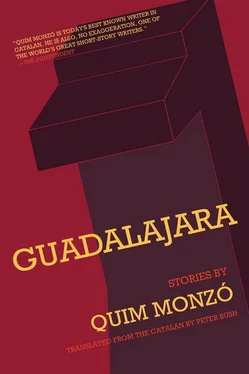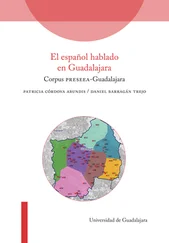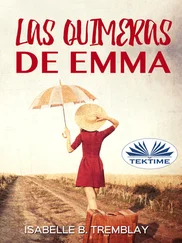Quim Monzó - Guadalajara
Здесь есть возможность читать онлайн «Quim Monzó - Guadalajara» весь текст электронной книги совершенно бесплатно (целиком полную версию без сокращений). В некоторых случаях можно слушать аудио, скачать через торрент в формате fb2 и присутствует краткое содержание. Год выпуска: 2011, Издательство: Open Letter, Жанр: Современная проза, на английском языке. Описание произведения, (предисловие) а так же отзывы посетителей доступны на портале библиотеки ЛибКат.
- Название:Guadalajara
- Автор:
- Издательство:Open Letter
- Жанр:
- Год:2011
- ISBN:нет данных
- Рейтинг книги:3 / 5. Голосов: 1
-
Избранное:Добавить в избранное
- Отзывы:
-
Ваша оценка:
- 60
- 1
- 2
- 3
- 4
- 5
Guadalajara: краткое содержание, описание и аннотация
Предлагаем к чтению аннотацию, описание, краткое содержание или предисловие (зависит от того, что написал сам автор книги «Guadalajara»). Если вы не нашли необходимую информацию о книге — напишите в комментариях, мы постараемся отыскать её.
Guadalajara — читать онлайн бесплатно полную книгу (весь текст) целиком
Ниже представлен текст книги, разбитый по страницам. Система сохранения места последней прочитанной страницы, позволяет с удобством читать онлайн бесплатно книгу «Guadalajara», без необходимости каждый раз заново искать на чём Вы остановились. Поставьте закладку, и сможете в любой момент перейти на страницу, на которой закончили чтение.
Интервал:
Закладка:
Within the week, however, news came from Barbastre of a third cousin’s birth (quite a distant one): five fingers. It suddenly became clear that speaking of random occurrences was inappropriate and that delaying a decision for nine years resolved nothing. Some family members argued there was no cause for alarm; the fact that children in the family were being born with five fingers on one hand was the consequence of a logical process of evolution. Even Uncle Reguard speculated that so many centuries (some spoke of millennia) of cutting off ring fingers had finally led to a mutation: babies in the family were being born with an extra finger in order to compensate for the one they’d lose at the age of nine. Other family members thought that his opinion was absurd and refused to accept there could be such a significant mutation after a few centuries, or even a few millennia. In fact, it didn’t matter who was right. For the first time, there was a deep schism in the family that threatened their harmony. On the one side, there were those who believed two fingers should be chopped off of children with five-fingered left hands (the ring finger, as usual, and this new intermediate finger between the ring finger and middle finger that doesn’t have a special name) and there was no need to wait until they were nine: it should be done immediately, in a show of strength, to stamp out any dissent. On the other, there were those who believed that, if the tradition was to cut off one finger, however many anatomical variants there might be, they should continue being loyal to tradition and only chop one finger off. A third opinion appeared in the heat of the debate, initially a minority view, defended by the stenotypist uncle and two sisters-in-law: they denounced the custom itself as barbaric.
•
It was particularly significant that the sisters-in-law had denounced the practice—after becoming convinced during their courtship, people who married into the family had always turned into the most enthusiastic champions of the rite. In fact, one of the culminating moments in the festivities (and the source of perennial leg-pulling in family reunions) was when, if relationships looked rock-solid, a member of the family would address their future partner, saying he must tell her something before their betrothal could be ratified. It was an act that would initially seem strange, though it wasn’t at all, and their joint future as a married couple depended on a proper understanding of the tradition. And then they would go on to say, “When our children turn nine, we chop the ring finger off their left hand.”
The idea would always meet with reticence (as if it were a kind of joke) and immediately after (when it was realized it was no joke) with horror. The objections were always the same: “How can you do something so barbaric in this day and age?”, “What’s the point?”, “You’re not going to do that to our children!” Then the persuasion process began, hours of conversation and arguments. Day after day refining, clarifying, stressing until the future spouse finally understood. From that point on they became the most ardent champions of the act, and (although, in principle, nobody asked them to do this) they surrendered their own ring fingers, so they could fully enter into the spirit of the family. They were also the first to demand the rite be carried out when the child was nine, with no holds barred, and volunteered to keep the child’s hand still.
That was why revisionism from that quarter of the family, from the converts who seemingly clung to the custom most, was so serious. But this consideration gradually ceased to be important; soon there were no distinctions, and everyone joined the initial caucus formed by the stenotypist and the two sisters-in-law. A fourth cousin was born with five fingers. Everything now escalated to a crisis-point: people began to distance themselves, and the reunion arranged for the beginning of December was postponed sine die . “Until a final decision is reached.” But many assumed this was simply a way to get them out of the fix and intuited that there never would be a final decision, apart from that declaration, which apparently wasn’t one.
•
They bought a harp for Armand and signed him up for music and harp lessons on Tuesdays and Thursdays after school. He practiced conscientiously and assiduously on the weekends, but it didn’t always show in performance. As it became clear the family custom of chopping off fingers was now a thing of the past, Armand’s desire to play the harp gradually waned, and the next year, the harp stayed in a corner accumulating dust, until years later when Elisard, one of his five-fingered cousins, took an interest. Whenever there was a family lunch at Armand’s (now they were lucky to have seven or eight relatives when before twenty or more always came), Elisard would go into Armand’s bedroom and play the harp. Every get-together he played better. Until in the end he was playing compositions by Halffter, Milhaud, and Ginastera, and (a family special request) songs from Paraguay, and a Mexican tune he kept encoring ever more zestfully. Armand’s parents suggested giving him the harp as a gift. Armand interpreted that as a hint (as a reproach, after he’d defended his vocation as a harpist so energetically and then shown so little interest). He saw no point in pandering to them and said he couldn’t care less what they did with it. His parents decided to present it to Elisard the next time he visited.
But Elisard never returned to Armand’s. Without the cohesive element of the ceremony, family reunions became more and more infrequent; less people went to the few that were held, and soon everyone found an excuse not to go: in winter, people had to go skiing; in the summer, to the beach; and in any season of the year there was always some commitment that couldn’t be cancelled. Within a few years, family reunions were ancient history, and even the closest relatives became strangers they spoke to once a year at most, and then on the phone.
Elisard was the only one everyone still had news of, because over time (some say it had to do with his small anatomical extra) he turned into an exceptional harpist, who restored to the instrument the prestige and high standing it had lost as a result of being little played for many years. Armand thought differently. He thought Elisard was a child prodigy who’d enjoyed a few years as a star but, as he got older, he cut a pathetic figure: he, his harp, and his mannered melodies. Now, as he leaned on the bar, Armand saw Elisard yet again on the TV next to the shelves of bottles. He looked around, swore at the top of his voice and advocated the need to reinstate the old custom of chopping off ring fingers, starting with that famous harpist’s. The others propping up the bar don’t even look at him. As they don’t listen to him, he recounts the story of his family. Two patrons who do finally pay him some attention decide he’s either mad or drunk, or both things at once. Only one girl seems to take a positive interest, and she sidles over when he stops talking. She is pretty and has a lovely smile and a lock of brown hair that hides half of her face, the way some women hide a glass eye.
2
Outside the Gates of Troy
The wooden horse was finally completed, polished and varnished, at the break of day. It had been hard work and required dozens of soldiers supervised by three master carpenters. Majestic and motionless, it rises above the centre of the beach. They leave it to dry the whole day. At night, watching carefully to ensure nobody can see them from the wall, the chosen warriors climb quickly up a hemp ladder, one after another, making no noise. They are armed with small bags, filled with salted meat to give them strength in the morning and a ration of water to slake their thirst, are tied to their belts. After the last warrior has climbed up, they pull in the ladder and close the door so it isn’t visible from the outside.
Читать дальшеИнтервал:
Закладка:
Похожие книги на «Guadalajara»
Представляем Вашему вниманию похожие книги на «Guadalajara» списком для выбора. Мы отобрали схожую по названию и смыслу литературу в надежде предоставить читателям больше вариантов отыскать новые, интересные, ещё непрочитанные произведения.
Обсуждение, отзывы о книге «Guadalajara» и просто собственные мнения читателей. Оставьте ваши комментарии, напишите, что Вы думаете о произведении, его смысле или главных героях. Укажите что конкретно понравилось, а что нет, и почему Вы так считаете.












